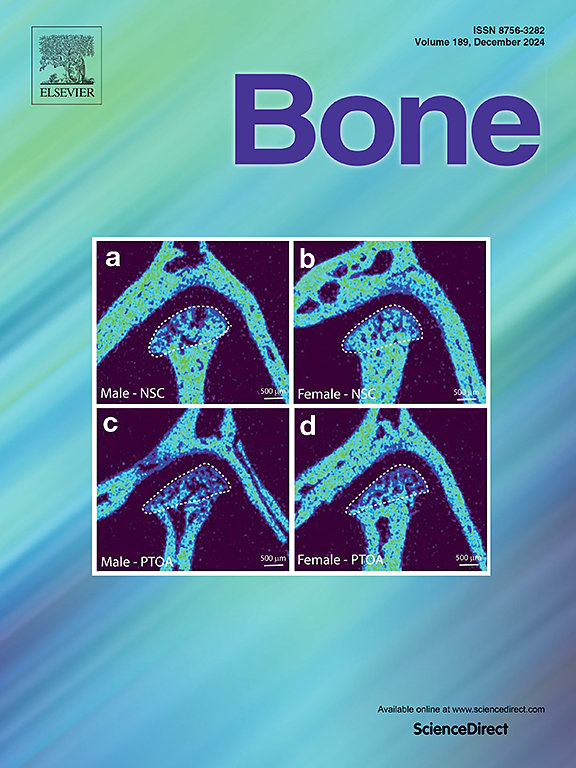估计脉搏波速度与中老年人髋部骨折的关系:中国的一项前瞻性队列研究
IF 3.6
2区 医学
Q2 ENDOCRINOLOGY & METABOLISM
引用次数: 0
摘要
背景:髋部骨折是中老年人面临的重大公共卫生挑战,对健康和生活质量有重大影响。本研究旨在调查估计脉搏波速度(ePWV)与髋部骨折风险之间的关系,并对总体人群和女性人群进行综合分析。方法利用中国健康与退休纵向研究(CHARLS)的数据,本前瞻性队列研究纳入了11,024名年龄在45岁及以上的参与者,随访9年(2011-2020)。研究采用Cox比例风险模型对总体人群和特定女性亚组进行分析。女性亚组分析独特地调整了绝经状态,以提供ePWV与髋部骨折风险关系的细致评估。通过限制三次样条(RCS)分析和阈值分析探讨ePWV与髋部骨折风险之间的非线性关系。结果在随访期间,记录了471例髋部骨折。在总体人群中,ePWV每增加四分位数,髋部骨折风险显著增加32%(危险比[HR]: 1.32, 95%可信区间[CI]: 1.18-1.49, p <;0.001)。在调整绝经状态后,女性亚组分析显示,每增加ePWV四分位数,髋部骨折风险增加29% (HR: 1.29, 95% CI: 1.09-1.53, p <;0.05)。非线性分析确定了11.18 m/s的临界阈值,超过该阈值,髋部骨折风险显著增加[95%CI: 1.28(1.12-1.47)]。结论ePWV与中国中老年人髋部骨折风险显著相关,为动脉僵硬度与骨折易感性之间的关系提供了新的见解。未来的研究应该验证这些发现,并探索以血管健康为基础的髋部骨折预防策略。本文章由计算机程序翻译,如有差异,请以英文原文为准。

Association between estimated pulse wave velocity and hip fracture in middle-aged and older adults: A prospective cohort study in China
Background
Hip fractures represent a significant public health challenge among middle-aged and older adults, with substantial implications for health and quality of life. This study aimed to investigate the association between estimated pulse wave velocity (ePWV) and hip fracture risk, with a comprehensive analysis of both overall and female population cohorts.
Methods
Utilizing data from the China Health and Retirement Longitudinal Study (CHARLS), this prospective cohort study included 11,024 participants aged 45 and older, with a 9-year follow-up period (2011-2020). The research employed Cox proportional hazards models to analyze the overall population and a specific female subgroup. The female subgroup analysis uniquely adjusted for menopausal status to provide a nuanced assessment of ePWV's relationship with hip fracture risk. Restricted cubic spline (RCS) analysis and threshold analysis were conducted to explore nonlinear associations between ePWV and hip fracture risk.
Results
During the follow-up period, 471 hip fractures were documented. In the overall population, each increment in ePWV quartile was associated with a significant 32 % increase in hip fracture risk (Hazard Ratio [HR]: 1.32, 95 % Confidence Interval [CI]: 1.18-1.49, p < 0.001). The female subgroup analysis, after adjusting for menopausal status, revealed a 29 % increased hip fracture risk per ePWV quartile increment (HR: 1.29, 95 % CI: 1.09-1.53, p < 0.05). Nonlinear analysis identified a critical threshold at 11.18 m/s, beyond which hip fracture risk significantly increased [HR (95%CI): 1.28 (1.12-1.47)].
Conclusions
The ePWV significantly correlates with hip fracture risk in middle-aged and older Chinese adults, offering novel insights into the relationship between arterial stiffness and fracture vulnerability. Future research should validate these findings and explore vascular health-based strategies for hip fracture prevention.
求助全文
通过发布文献求助,成功后即可免费获取论文全文。
去求助
来源期刊

Bone
医学-内分泌学与代谢
CiteScore
8.90
自引率
4.90%
发文量
264
审稿时长
30 days
期刊介绍:
BONE is an interdisciplinary forum for the rapid publication of original articles and reviews on basic, translational, and clinical aspects of bone and mineral metabolism. The Journal also encourages submissions related to interactions of bone with other organ systems, including cartilage, endocrine, muscle, fat, neural, vascular, gastrointestinal, hematopoietic, and immune systems. Particular attention is placed on the application of experimental studies to clinical practice.
 求助内容:
求助内容: 应助结果提醒方式:
应助结果提醒方式:


